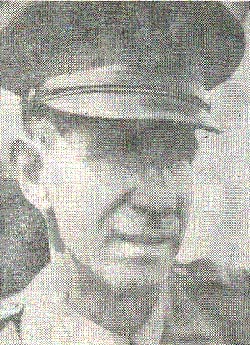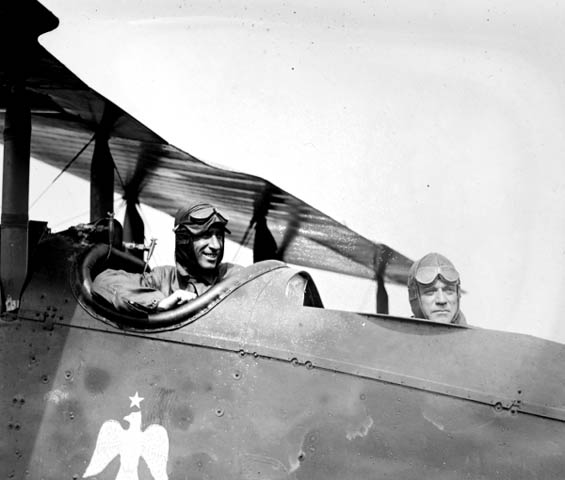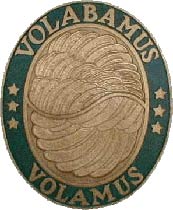William C. Ocker, 1930
(Source: San Antonio Express, May 4, 1930)
 |
William C. Ocker (June 18, 1880-September 15, 1942) was one of the pioneers of
instrument flying, and, like Albert
Hegenberger, spent a
decade or more of his military service inventing and contributing
to the science of blind flight.
He landed three times at Tucson between 1928 and 1931,
flying Douglas aircraft (two landings in AAC #25-400 carrying non-commissioned passengers). His flights to and from Tucson occurred
about the time he was performing his instrument flight experiments
and designing the equipment to train pilots in the art of
instrument flying.
Image, left, from the San Antonio Express, May 4, 1930,
which features an article about the testing performed by
Ocker at Brooks Field, San Antonio, TX. He used a device of his own invention that incorporated
a box with primary flight instruments in it, encased in a
wooden box with a hole against which a pilot would place
his face. The device was mounted on a swivel chair. The device
is pictured in the news article.
The pilot
sat in the chair with his face sealed against the box and
an instructor rotated the chair while the pilot observed
the behavior of the instruments. The basic lesson was that
the pilot's kinesthetic senses would soon conflict with what
the instruments were telling him and disorientation would
result if the pilot did not "believe the instruments". An article published in the August-September 2009 issue of Air & Space magazine further describes the "Ocker Box", as his device was named, and shows additional photographs of it.
Below, Ocker sits in his cockpit.
William Ocker in the Cockpit of His Airplane, Date & Location Unknown (Source: Mike Gerow)
 |
His device was patented by Ocker and
his military colleagues and licensed to the Link company
who manufactured the "Link Trainer" for military
use. This series of events is documented in a special citation
awarded to Ocker and his colleague and Register pilot Carl J. Crane by the Order
of Daedalians (he is a member), which document is in Ocker's
NASM biographical file (left sidebar). However, I am unable to corroborate on the Web
or in books this connection to the Link company.
More recently (2008), an online article from Invention & Technology: The Magazine of Innovation explored Ocker's methodology
A typical flight instructor in 1917 would point to the instruments in a cockpit and tell his students to “pay no attention to them.” In aviation’s early days, pilots flew by the “seat of their pants.” They trusted their eyes and gut feelings, even though doing so sometimes killed them, especially when vertigo set in at night or during bad weather. Such loss of equilibrium was considered part of the business, a rite of passage that fliers just had to handle. A pilot who relied on any instruments other than the compass, and perhaps the altimeter, was a lightweight—or even worse, a coward.
William Charles Ocker, “the father of blind flying,” didn’t buy into such macho posturing. As an Army pilot in World War I, he had known too many competent fliers who became disoriented and died needlessly; he himself had narrowly escaped death in 1918 while testing one of Elmer Sperry’s early turn indicators. Lost in clouds with no visibility, Ocker discovered that the indicator showed his plane in a turn while his senses told him he was straight and level. The confusion sent him into a spiral dive: emerging from the clouds, he had just enough time to regain control. Others might have blamed the instrument. Ocker understood that, despite his training and experience, his pilot instincts had failed him.
The bowlegged, bifocal-wearing Ocker hardly fit the stereotype of a daring pilot or one who might challenge conventional wisdom, but he had a passion for flying and a fierce sense of mission. Born in Philadelphia in 1876, he enlisted in the Army at 22 and fought in the Spanish-American War and the Philippines as an artilleryman. In 1909 he met the Wright brothers while guarding their Wright Flyer during military tests at Fort Myer, Virginia. Fascinated by airplanes, he transferred to the Signal Corps’ Aviation Section in 1912. Starting out as an aircraft mechanic, he earned his wings in 1914 and an officer’s commission three years later.
Throughout his career, Ocker remained haunted by his close call and the reasons why it happened. A routine physical exam in 1926 at Crissy Field in San Francisco finally provided him with some answers. The flight surgeon, Capt. David Myers, sat Ocker in a Jones-Barany chair, a swiveling, spinning seat designed to measure a person’s sense of balance and equilibrium, and challenged him to take the exam with his eyes closed. Ocker discovered that when robbed of visual cues he couldn’t tell whether the chair was spinning or stationary, or even what direction he turned. Myers had re-created the same disorientation that Ocker had experienced eight years earlier.
Ocker devised a way to beat Myers’s test by rigging a turn indicator and penlight inside a covered shoe box with a viewing hole cut in one end. Seated in the chair, he held the box up to his face and watched only the instrument. Even though he was “flying blind,” he could now tell Myers precisely which way he moved and how fast. Ocker had proved that conflict can exist between a pilot’s subjective perceptions and the readings of his instruments—and that he should trust the instruments, not his instincts, when that occurred.
With evangelical zeal, Ocker spread news of his discovery to other pilots. He perfected his “Ocker box,” adding standard aircraft instrumentation such as a compass and artificial horizon, so that pilots could use the box in conjunction with the Jones-Barany chair as a training device. Even the most experienced, instrument-skeptical aviators could not help but be convinced after a spin in Ocker’s rudimentary flight simulator. Despite the evidence, the Air Corps stubbornly insisted that “blind” instrument flying was unnecessary, dangerous, and would not become part of its pilot training program. Many pilots learned it anyway under Ocker’s tutelage. Some of his superiors remained suspicious of this odd officer who liked to spin in chairs, more than once forcing him to undergo psychological examinations.
Ocker persisted, taking his ideas with him to his new assignment at the Air Corps’ main training center at Brooks Field in Texas. Along with the Ocker box, he invented the notion of the covered cockpit, in which a pilot has to rely strictly on instruments in flight training. The Army Air Corps might have disapproved, but Pan American Airlines soon adopted his methods in their flight school. He challenged the instrument-flight skeptics further by making the first cross-country flight in a completely covered cockpit, a nearly 900-mile jaunt from Brooks Field to Scott Field, Illinois, on June 24, 1930. (The year before, young Army officer Jimmy Doolittle had become the first pilot to take off, fly, and land completely on instruments, but that had only been a brief circle around an airport.)
Ocker’s research caught the attention of Lt. Carl J. Crane, another pilot who’d had a close call when he lost his bearings on a flight in 1925 and just missed the top of Detroit’s Statler Hotel with a congressman’s son in the back seat. Ocker and Crane conducted numerous experiments on instrument flying and pilot disorientation, most famously by tossing blindfolded pigeons out of an airplane in flight. They found that these birds exhibited the same disorientation as did pilots when confronted with severe cloud cover or darkness. (Most of the birds recovered their bearings or managed to shed their blindfolds.)
In 1932 Ocker and Crane distilled their research into the world’s first instrument flight manual, Blind Flight in Theory and Practice. While the U.S. military was slow to acknowledge the book’s value, the Soviet air force quickly adopted a pirated edition as a standard text.
Ocker’s restless energy led him to pursue other aviation innovations. In 1938, along with Lt. George Smith, he patented a propeller with hinged blades for quieter flight. In 1941 Ocker and Crane created a “preflight reflex trainer,” essentially a ground flight simulator “pilot buggy” with a cockpit that could move in three axes, powered with a one-cylinder engine and complete with a .22-caliber blank-firing machine gun for target practice. Ocker also invented a “flight integrator,” a gyroscope-driven instrument that displayed a plane’s movements with a miniature plane on a screen depicting a sky complete with clouds. More concerned with the welfare of his fellow flyers than with profit, he assigned his patents to the government.
Controversy continued to stalk Ocker. In 1934 he was court-martialed for supposedly making insubordinate comments about a superior officer. When he proved that the officer had falsely doctored Ocker’s medical records to keep him grounded after an accident, he was quickly acquitted.
Ocker also made some influential friends along the way, including Orville Wright, who called him a “missionary” with “more influence in bringing about the use of instruments than any other person.” He counted Eddie Rickenbacker, Billy Mitchell, and Jimmy Doolittle among his supporters. Charles Lindbergh, Amelia Earhart, and pioneering Australian aviator Charles Kingsford-Smith learned about instrument flying from him personally. When he retired as a full colonel, he was the oldest serving pilot in the U.S. military.
Ocker died at Walter Reed Hospital in Washington, D.C., on September 15, 1942. The following year, the military authorities finally made his instrument training procedures standard for all pilots. Few remember Ocker today; no airports, aviation companies, or museums bear his name. Yet he would be happy enough to know that he rides with every pilot who relies on instruments to find the way home. |
It is surprising
also that, upon review, no connection is made between Ocker's
work at Brooks Field, San Antonio, TX and Hegenberger's work
at Wright Field, Dayton, OH, all against the problem of instrument
flight. Perhaps it is because Ocker's work had to do mostly
with attitude instrumentation (cited on page 9 by Miller
in the book listed in the left sidebar) and the neuropsychological
aspects of instrument flight, while Hegenberger's dealt with
radio instrumentation and navigation.
Ocker's court martial at Brooks Field, was described in Time Magazine of January 22, 1934. If this had anything to do with the lack of connection between his and Hegenberger's work, it's not clear from the article. The article is quoted in the box below.
"When the Wright Brothers were experimenting with their flying contraption at College Park, Md., 25 years ago, they were pestered by a young Army corporal named William C. Ocker who wanted to take lessons. When they made their first successful test flight for the Army at Ft. Meyer, Va., Bill Ocker was there as an armed guard. From a greasemonkey and bamboo polisher at Curtiss Flying School, Corporal Ocker rose to be a pilot, then an inventor. Flying upside down in the clouds made him dizzy so he helped devise an instrument to prevent vertigo. When flying by instruments alone was scoffed at, he built a little black box full of indicators which not only made blind flying simple but two years ago led the Army to require it of every flyer in the service. Congress appropriated $1,000 to buy up his patent. But last week at Ft. Sam Houston, Major Ocker, oldest pilot in the Army in point of service, was summoned to appear before a court-martial. Charge: insubordination—by using improper language to a superior officer (96th Article of War). Major Clyde C. Johnston had examined Pilot Ocker at Kelly Field, after he recovered from a broken vertebra, and grounded him for weak eyesight. Pilot Ocker, no friend of Kelly Field's hard-boiled com- mander, Lieut.-Colonel Henry B. Clagett, took his re-examination at another field, managed to pass the eye test. Back he went to Major Johnston and, according to the court-martial charges, said: 'If other pilots on this field, namely such as Clagett, were given more than a cursory examination they too would be off flying status. There was collusion between you and the Commanding Officer of this field relative to my examination!'"
|
Further, the San Antonio Express, March 10, 1934 gave first-hand accounts of the end of the court martial. Headline:"Ocker Acquitted by Courtmartial in 12 Minutes." His nemesis in the proceedings was Register pilot Lt. Col. H.B. Clagett. However, Ocker amassed a cadre of witnesses that vouched for his character and value to the Army. Among them were several Register pilots: Jimmy Doolittle, Frank Hawks, Amelia Earhart, Clarence Young and F. Trubee Davison.
The fact remains, Ocker's and Hegenberger's work was contemporaneous, and together they developed the basis for control
of aircraft under raw instrument meteorological conditions
that remains to this day with few embellishments. Any contemporary
instrument-rated pilot can relate to the challenges and skills
Ocker and Hegenberger met and trained against with their
primitive devices over 75 years ago. Below, courtesy of site visitor Andy Heins, Ocker occupies the front cockpit with General Menoher in the rear.
William Ocker (L) and General Menoher, Date & Location Unknown (Source: Heins)
 |
Ocker reached the rank of Colonel and this link provides
information, images and other links about him. Some sources cite his birth year as 1876. He has a modest Web presence.
---o0o---
Dossier 2.2.138
THIS PAGE UPLOADED: 01/14/07 REVISED: 12/21/09, 05/10/10, 09/09/11, 04/14/14, 10/28/16
|




